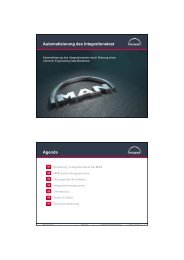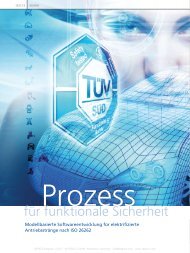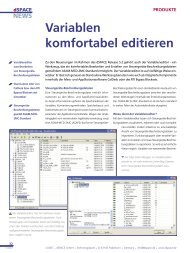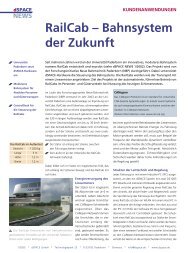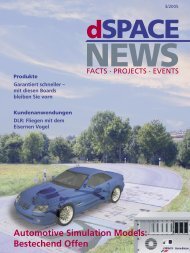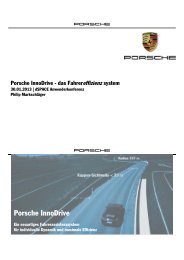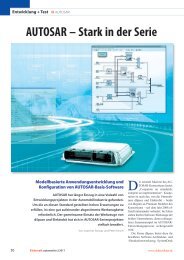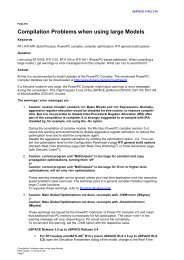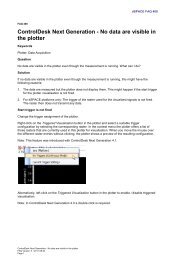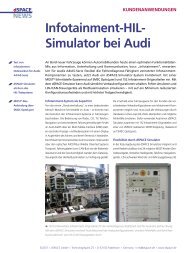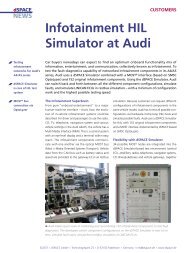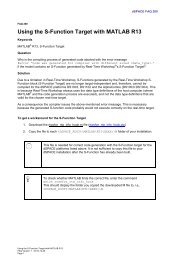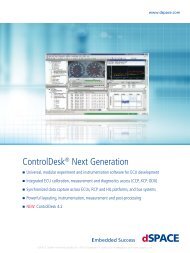magazinE - dSPACE
magazinE - dSPACE
magazinE - dSPACE
Create successful ePaper yourself
Turn your PDF publications into a flip-book with our unique Google optimized e-Paper software.
pAGe 26 HIL AND SIL<br />
test and validate the entire controller<br />
software under development at an<br />
early stage. In an ideal process, the<br />
same model is used for SIL and HIL<br />
testing, since the parameterization<br />
can be reused and signals can be<br />
compared directly. After Caterpillar<br />
chose the ASM Diesel Simulation<br />
Package from <strong>dSPACE</strong> to perform<br />
HIL tests, the goal was to run realtime<br />
simulations with the package<br />
during function design. The company’s<br />
inhouse simulation environment,<br />
Dynasty, was extended to<br />
execute not only Caterpillar’s highfidelity<br />
models but also the mean<br />
value models from <strong>dSPACE</strong>. Caterpillar<br />
and <strong>dSPACE</strong> worked together<br />
closely to integrate the simulation<br />
models. To transfer the parameters<br />
from Enterprise to the ASM, a solution<br />
based on a table with onetoone<br />
variable referencing was<br />
implemented. Measurement data<br />
either from the real engine or from<br />
the simulation is required to<br />
complete the parameterization.<br />
Co-simulation<br />
To evaluate the ASM diesel and<br />
turbocharger models and check that<br />
their quality and performance is<br />
sufficient, they were cosimulated<br />
with the Enterprise model in Dynasty<br />
and the results were compared.<br />
During cosimulation the ECU code<br />
was connected to the inputs and<br />
outputs of the ASM diesel engine<br />
model. The model was parameterized<br />
with ASMPara. Steadystate<br />
simulation results were checked<br />
against measurement data. Dynamic<br />
simulation results were compared<br />
with transient measurement data<br />
and with the Enterprise simulation<br />
results based on test cycles like the<br />
EPA NonRoadTransientCycle.<br />
The simulation results of the ASM<br />
models matched the reference<br />
signals with excellent agreement in<br />
every case. As a result the ASM<br />
Diesel Engine Simulation Package is<br />
now used for controller validation<br />
during offline simulation and for<br />
ECU validation during HIL simulation.<br />
Caterpillar’s machinery<br />
produces unmistakable<br />
results.<br />
ECU Testing at Caterpillar<br />
Caterpillar already equipped its testing<br />
laboratory with numerous HIL<br />
test benches from <strong>dSPACE</strong>, ranging<br />
from MidSize to FullSize systems.<br />
These are used to test ECUs for the<br />
engine, transmission, and other<br />
parts of the equipment. Using ASM<br />
has made parameterization much<br />
easier, since parameters are available<br />
early in the development process<br />
when SIL is performed. Another<br />
advantage is that the open model<br />
design lets you easily couple custom<br />
transmission and drive train models<br />
with the ASM diesel models. Thus<br />
the HIL benches can be configured<br />
to match any project.<br />
The Benefits of aSms<br />
Practical experience has shown that<br />
performing realtime HIL and SIL<br />
tests with the same model makes<br />
development much more efficient.<br />
Moreover, we have used ASM diesel<br />
engine and turbocharger blocks<br />
for a wide range of engines



